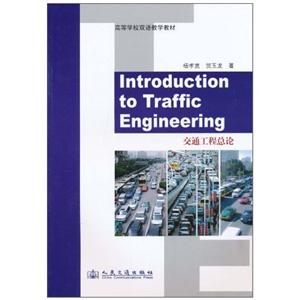交通工程总论 目录
Chapter 1 Introduction1.1 Definition, scope and goal1.2 Traffic system1.3 Background of development of traffic engineering1.4 Responsibility and liability ( professional ethics )1.5 Transportation legislation1.6 Characteristics of traffic engineering and challenges that traffic engineers face1.7 Explanation of some technical terms1.8 ReferencesChapter 2 Basic Concepts and Components in Traffic Engineering2.1 Mobility versus accessibility2.2 Classification of roadways2.3 Uninterrupted and interrupted flows2.4 Perception-Reaction Time (PRT)2.5 Visual acuity Static versus dynamic2.6 Walking speed2.7 Vehicle characteristics2.8 Geometric characteristics of roadways2.9 Traffic control devices2.9.1 Traffic signs2.9.2 Traffic markings2.9.3 Traffic signalsChapter 3 Volume, Density & Speed Studies3.1 Definition of volumes3.2 Definition of speed3.3 Density3.4 Relationship among volume, speed and density3.5 Derivation of flow-speed and flow-density relationships3.6 Finding capacity from basic speed-flow-density curvesChapter 4 Spot Speed, Travel Time, and Delay Studies4.1 Spot speed studies4.2 Travel time studies4.3 Delay studiesChapter 5 Statistics and Application in Traffic Engineering5.1 Some basic concepts5.2 Distribution of traffic flow5.2.1 Poisson distribution5.2.2 Binomial distribution5.2.3 Exponential distribution5.3 MIMI1 system—— queuing theory application5.4 Chi-square (x2) goodness-of-fit testChapter 6 Highway Capacity Analysis6.1 Capacity, level of service and other related concepts6.1.1 Definition of capacity6.1.2 Concept of level of service and measure of effectiveness6.1.3 Other related concepts6.1.4 Factors affecting capacity &LOS ( base conditions )6.1.5 Factors affecting the free-flow speed6.1.6 Samples for free-flow speed estimation6.2 Two types of analysis6.2.1 Steps for operational analysis6.2.2 Example for operational analysis6.2.3 Steps for design analysis6.2.4 Example for design analysis6.3 Capacity analysis for two-lane highway6.3.1 Classification of two-lane highway6.3.2 Capacity of two-lane highway6.3.3 LOS for two-lane highway6.3.4 FFS for two-lane highway6.3.5 Operation analysis for two-lane highway6.4 Capacity & LOS analysis for weaving, merging, and diverging on freeways and multilane highways6.4.1 Basic knowledge6.4.2 Capacity of weaving area6.4.3 Level of service criteria6.4.4 Analysis of weaving areas6.4.5 Analysis of merge and diverge areasChapter 7 Fundamentals of Intersection Design7.1 Introduction to intersection control7.1.1 Types of intersection7.1.2 Hierarchy of at-grade intersection control7.1.3 Capacity analysis of TWSC intersection7.2 Basic principles and steps of intersection signalization7.2.1 Terms and definitions7.2.2 Saturation flow rate, lost times and capacity7.2.3 The critical lane and time budget7.2.4 Concept of left-turn and right-turn equivalence7.2.5 Delay as a measure of effectiveness7.3 Fundamentals of signal timing and design7.3.1 Development of phase plan7.3.2 Determination of vehicular signal parameters7.3.3 Determination of pedestrian signal parameters7.4 Computer software related to intersection signal timingChapter 8 Traffic Control Devices8.1 Definition and categories of traffic control devices8.2 Introduction of MUTCD8.2.1 History and background of MUTCD8.2.2 General principles of the MUTCD8.2.3 Contents of the MUTCD8.3 Traffic markings8.3.1 Longitudinal markings8.3.2 Transverse markings8.3.3 Object markers and delineators8.3.4 Word and symbol markings8.4 Traffic signs8.4.1 Regulatory signs8.4.2 Warning signs8.4.3 Guide signs8.5 Traffic signals8.5.1 Characteristics of traffic signals8.5.2 Traffic signals warranty8.5.3 Pedestrian signals8.5.4 Other traffic signalsGlossaryReferences
展开全部
交通工程总论 节选
《交通工程总论》为高等学校双语教学教材。全书共分8章,第1章简要介绍了交通工程学的发展史以及定义、研究范围和目标;第2章包含交通工程中常用的基本概念包括:机动性和可达性,道路分类,连续流和间断流以及驾驶员和车辆的特性;第3章讨论了流量、速度、密度以及三者之间的关系;第4章详细介绍了地点速度、出行时间和延误的特性;第5章讲述了统计学在交通工程中的应用;第6章讨论了道路通行能力,主要介绍了高速公路基本路段和双车道通行能力的计算;第7章描述了交叉口设计的基本过程;第8章介绍交通控制设备。《交通工程总论》可作为高等院校交通工程、交通运输、土木工程等专业本科生双语教学用教材,也可供从事交通工程研究的专业技术人员参考。
交通工程总论 相关资料
插图:Besides, development of computer science and communication has improvedtraffic system.A good example is the introduction of Intelligent TransportationSystem(ITS, 智能交通系统),which brings transportation discipline into a newepoch~ In general Intelligent transportation system (ITS) refers to efforts to addinformation and communications technology to transportation infrastructure andvehicles in an effort to manage factors that typically are at odds (对立) with eachother, such as vehicles, loads, and routes to improve safety and reduce vehiclewear, travel times, and fuel consumption.Sustainable transportation development (可持续交通发展) is a more recentconcept liking environmental, economic, and social use values with the constructionof traffic infrastructures. The ultimate goal is to identity the level of development thatcan be sustained without critical environmental damage, while meeting economicand social needs of present and future generations. Preservation of naturalresources and exploration of new energy become vital steps toward sustainabiiity.As a result environmental factors have been gradually involved in the development oftransportation~Development of Traffic Engineering in ChinaTraffic engineering was introduced into China rather late, compared to othercountries. In 1980 traffic engineering course was first offered for undergraduatestudents at Beijing University of Technology in mainland China~ In the followingyears many colleges and universities opened this course either affiliated to CivilEngineering Department or under Transportation College. Nowadays, there aremore than 90 colleges and universities in China to offer traffic engineering programwith Master and Ph.D. degrees.





















